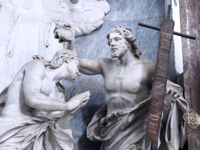FRANCESCO BORROMINI - III PART
While engaged in Saint John, Francis found time to enlarge Falconieri Palace, where his most important work was the construction of the magnificent three-arched loggia overlooking the River Tiber.
The palace was once belonged to the Farnese family, from which Horace Falconieri, friend of Borromini, bought it and asked Francesco to remodel.
Adverse to the Barberini family, Pope Innocent X Pamphili wanted to overcome them in magnificence and if those had built a palace for their family, Innocent wanted an entire square.
 |
| Navona square - click to enlarge |
So it was that Navona square acquired its present appearance. First the Pamphili bought a number of buildings which then demolished to build Pamphili palace and the Church of St. Agnese in Agone, which is so called because the square faithfully follows the design of the stadium of Domitian, named “Campus Agonis”, where the Romans carried out what we might call the Roman Olympics. So St. Agnese was named in Agone and the square Nagona and finally Navona.
Built the palace, it lacked the church: the task was entrusted to Girolamo Rainaldi, but Innocent X, not satisfied with the project, dismissed Rainaldi and in 1652 called Borromini, who, put aside the project of Rainaldi, designed the façade with the typical Borromini style,
raised the imposing dome on a drum with eight windows which illuminates the interior and to finish at the sides of the church built the Innocent’s college.
Since before the construction of the church Bernini, always on behalf of Innocent X, had erected the Fountain of the Four Rivers, given the rivalry between Bernini and Borromini, the more imaginative rumors began to circulate.
For example, it was said that the statue of the River Plate has the hands outstretched towards the church for protection from its collapse. Funny, but the fountain was completed in 1651, while the works for the construction of the church began only a year later.
Innocent X died in 1655 and his heirs began to challenge the actions of Borromini, who disdained in 1657 gave it up. As substitute was called Carlo Rainaldi, son of that Girolamo to whom had succeeded Francesco.
Rainaldi took his time (also for the stinginess of the heirs of Innocent X), so that the work was completed only in 1672. With the help of John Baratta, he modified the project of Borromini in particular, while Borromini had designed two small, 2 storied, bell towers, the lower convex to the upper concave, Rainaldi built two tall bell towers both convex shape.
Unfortunately this intervention both mortify the fantasy of Borromini, and impacts on the stateliness of the dome.
 |
| The dome - click to enlarge |
While Innocent X entrusted Francesco with the construction of St. Agnese, thanks to the Marquis Del Bufalo, the Fathers of San Francesco found the money to complete their church of Sant'Andrea delle Fratte and of course they gave the job to Francesco, who worked there until his death, building the dome and the bell tower.
But even the money of the Marquis ended and so the dome remained devoid of coating.
Thanks to the skills of Francesco one does not feel the lack of coating, indeed you can appreciate even more the great expressiveness of the drawing.
While pure white is the lining of the bell tower, called “ballerina” (=dancer) because it seems to sway when the bells swing.
Going up to a few tens of meters along Capo le Case street, you have a good view of the bell tower, with its three orders.
In the first order between the capitals of the columns we see the faces alternately in women and men, the men face each other and so the young women.
What Francesco wanted to symbolize, is not clear, at least to me. Perhaps this look in the eye, compared with the angels of the second order, looking away, could be a suggestion to look inside themselves, whatever the sex and at any age.
In the second order, played in the alternation of concave and convex forms, the eight angels looking at the horizon, convey a feeling of calm serenity.
Four scrolls on the crowning, among which you can see the coat of arms of Del Bufalo family, support the flaming crown of the Faith, on which rests the Cross.
The years passed, we get to 1662, when died father Virgilio Spada.
A tremendous blow to Francis that lost one of his few friends and his main mentor. Fate would have that in the same year Francesco had completed the Spada chapel in San Girolamo of Charity.
Lonely and embittered by the fierce criticism Francesco closed more and more into himself, taking refuge and spending all his energy into the work.
In 1664 his friend Horace Falconieri commissioned the family chapel in San Giovanni dei Fiorentini. Francis designed the chapel and the underlying crypt.
 |
 |
 |
| Falconieri chapel - click to enlarge |
Almost opposite the chapel is the tomb of his beloved uncle Carlo Maderno,
next to which Francis wanted to be buried. Therefore it is easy to see how hard he set to work.
But more and more alone Francesco sank into depression.
On the night of August 1, 1667, the irreparable happened, he struck himself with his dagger, died after three days of agony.
According to his will Francesco was buried close to Carlo Maderno, in front of his Falconieri chapel, under the eyes of the Eternal Father that seems welcome him in his merciful embrace.
BORROMINI AT ROME

back |

